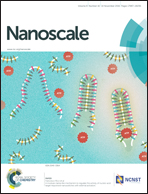A modular clamp-like mechanism to regulate the activity of nucleic-acid target-responsive nanoswitches with external activators†
Abstract
Here we demonstrate a general and modular approach to regulate the activity of target-responsive DNA-based nanoswitches. We do so by coupling together two DNA-based responsive elements: a triplex-forming clamp-like probe able to bind a specific DNA sequence and a split aptamer selected to bind a small molecule. In the presence of the specific target of one of the above responsive elements, the nanoswitch partially folds and its ability to bind the second target is restored. With this approach we can finely modulate the affinity of both DNA-recognition elements and aptamers using an external ligand. The modular nature of our strategy makes it easily generalizable to different DNA based recognition elements. As a demonstration of this we successfully designed five different DNA nanoswitches whose responsiveness can be regulated by different molecular effectors and targets. The convenience with which this mechanism is designed suggests that it may prove a useful tool by which sensors, genetic networks and other biotechnology devices employing nucleic-acid based receptors can be controlled with an external input.


 Please wait while we load your content...
Please wait while we load your content...